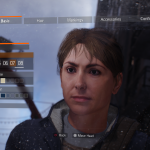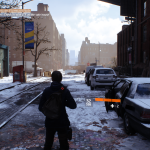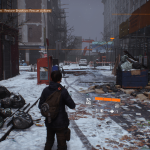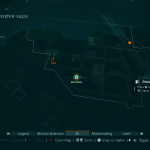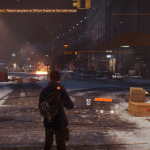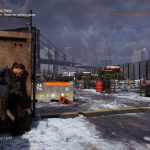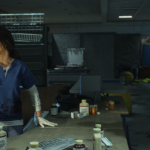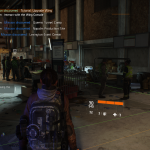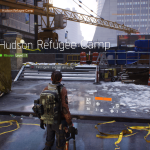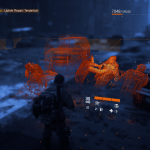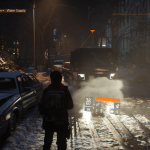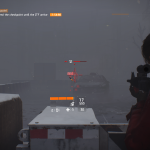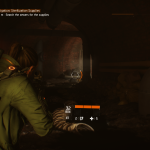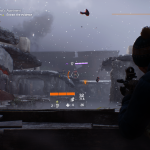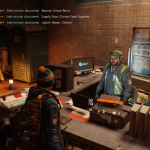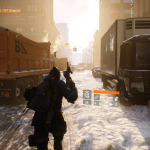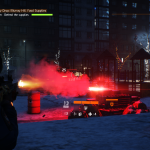 Tom Clancy’s: The Division is a new original game from Ubisoft Massive. This developer originally started out as Massive Entertainment in 1997 and worked on some great strategy games like Ground Control and World in Conflict. When they were picked up by Ubisoft in 2008, they helped put out with Assassin’s Creed: Revelations and Far Cry 3. The pedigree of this studio is great. The other side of this story is the Tom Clancy name. Those with a long memory will remember his name hitting games as far back as 1998 with the original Rainbow Six but games based upon his books reach all the way back to 1987. In a rapidly evolving industry, the Tom Clancy name has brought to life several innovative and popular franchises like the aforementioned Rainbow Six, Ghost Recon, Splinter Cell, and several others. There were a few misses but for the most part, it has been a mark of a quality game. Especially with the resurgence of Rainbow Six with Siege this past year, the name being on The Division should indicate some confidence on the part of Ubisoft and Massive. With these two facts combined, the pedigree of the studio and the Tom Clancy name, this should make anyone hyped about the potential of this game.
Tom Clancy’s: The Division is a new original game from Ubisoft Massive. This developer originally started out as Massive Entertainment in 1997 and worked on some great strategy games like Ground Control and World in Conflict. When they were picked up by Ubisoft in 2008, they helped put out with Assassin’s Creed: Revelations and Far Cry 3. The pedigree of this studio is great. The other side of this story is the Tom Clancy name. Those with a long memory will remember his name hitting games as far back as 1998 with the original Rainbow Six but games based upon his books reach all the way back to 1987. In a rapidly evolving industry, the Tom Clancy name has brought to life several innovative and popular franchises like the aforementioned Rainbow Six, Ghost Recon, Splinter Cell, and several others. There were a few misses but for the most part, it has been a mark of a quality game. Especially with the resurgence of Rainbow Six with Siege this past year, the name being on The Division should indicate some confidence on the part of Ubisoft and Massive. With these two facts combined, the pedigree of the studio and the Tom Clancy name, this should make anyone hyped about the potential of this game.
The story takes place in the near-future after a massive biological attack that takes place on Black Friday. The government has activated its last failsafe to restore order, the Division. This is a group of highly trained individuals that have been empowered to do whatever it takes to do the job. The game takes place after the first wave of agents have either died or gone missing. You are part of the second wave and are headed to ground zero in New York City. The city is in shambles with everyone vying for survival and some few aspiring for power and control. Your job is to regroup the fragmented government forces, retake the city, and get to the bottom of the outbreak.
The premise of the game is great and the world created by Massive does a good job supporting it. The visual of a New York City in complete disrepair is impressive. The supporting cell phones and incident reports give a great backdrop of how the city fell from the perspective of those who were there but the main story on the other hand is quite simplistic. This is perhaps a side-effect of having an open world, prioritizing replayability, or the ability to tackle most of them out of order but there is definitely something missing. There is not much weight behind what is going on which leads you to not particularly care what is happening. It feels like a story by the numbers and not an engrossing rich story. The main character is a mute and the cast around you is not that special. The main narrative is definitely a disappointment but the world and the side content sells what the main story does not.
The Division is a third-person cover shooter that shares elements of role-playing as well as massively multiplayer online games. Most will immediately compare it to Destiny, which has some merit. This title is the latest in a resurgence of pseudo-massively multiplayer online games. The concept is not new though. You will find similar ideas in Diablo 2 and the Phantasy Star games. The way these games sell the concept is to have lobbies where other players are visible and then let you break off to do your own thing or group up with some of them. While The Division is entirely able to be played alone but it’s definitely best with others.
When you start the game, the first action you will take is to create your character. It is a typical set up with you selecting your gender, face, hair, and add-ons. Compared with other titles in the genre, the options are quite limited, especially in the area of the face. There are only a handful of different faces for each gender which knocks out the foundation before it was even built. Luckily, the game has a lot of different apparel options in the game to make your character somewhat unique. The other design choice made is that your armor selections do not overwhelm the look of your character. The apparel have no statistics so the end game won’t end up with everyone looking the same.
At the heart of this game is a solid role-playing foundation. Unlike other titles where your path is chosen upfront, in The Division you can play however you like and change whenever you like. It allows you to easily customize yourself for single-player, cooperative play, or the possibility of facing others in the Dark Zone. On the other side of this equation, while the foundation is solid, it is quite simplistic. Completing missions for the different wings of your base unlock different abilities and passive boosts to various aspects of your character. Leveling up just allows you access higher level gear and engage in higher level enemies without dying. With each enemy taken down and each quest accomplished, you’ll have the chance to get loot. The loot system is quite nice, consistently rewarding you with meaningful new additions to your arsenal. When brought together, there is enough pieces to create an addictive and enjoyable atmosphere. While at the end of the road there is some grinding, it will take well over 10 or 20 hours to start hitting that point.
The next component of this game is the gunplay. As with all cover-based shooters, approaching each scenario with care is the best course. If you are well over the level for some enemies, they may be easily dispersed by running and gunning. If you are on par or lower than them, the path to success is always cover. Now the system is not as refined and well done as others, it is definitely more than serviceable. The biggest issue, which is highlighted at the beginning of the game, is that for the most part you are alone unless you opt to play with others. Games like Gears of War and Mass Effect make use of other player characters to allow for a more tactical experience. Here, you’re left with the enemies making mistakes to turn the tide of battle. For example, if you’re a good aim, you can snipe the heads of the opponent behind cover. If you wait long enough, they will try to head for another piece of cover. Certainly down the line you gain a couple abilities that can assist those playing alone but for the most part you rely on their mistakes rather than your tactical approach. The other issue with the gameplay is an overreliance on wave-based combat. Clear a wave of enemies, another wave shows up until the encounter is deemed over. Once you understand this system, the game starts to become a lot more fun. It takes about an hour to grasp this though and can make the beginning feel a little lackluster.
As time goes on though, the gameplay gets a lot more addictive. After that first hour of figuring out the game you break out into a highly enjoyable and entertaining game for the next dozen hours. While the simplicity of the gameplay starts to become more apparent, it doesn’t become too bothersome. The main missions are quite diverse and a lot of fun. The side missions are decent and varied. But over time what use to feel fresh and new starts to lose its luster. The gunplay never gets old but some of the side missions definitely do. The ones with carrying an object or being timed to find certain objects start to get very repetitive and sometimes even annoying. The other aspect that starts grating at the experience is how the difficulty increases as handled. The enemies don’t gain new tactics or start to require specific tactics to defeat, they simply take more and more bullets. Even the bosses are just beefier and spongier versions of their lesser selves. While the midgame experience is very satisfying, the experience starts to coast more and more on the drive for more loot.
When you reach the end of the main story and hit the max level of 30, it is time to hit the daily missions and continue for more loot in the Dark Zone. The daily missions are higher difficulty versions of the missions you completed in the main campaign. These will give you access to better gear as well as a new currency type to buy even better gear. The Dark Zone has its own ranking system in addition to the level of your character. This rank can go up to 99 and will determine if you can buy certain gear from the Dark Zone vendors. The other caveat of this is that based upon your deaths and if you go rogue, this rank can go up and down. Unfortunately while these two aspects definitely do give the game life after the story, there is not much to it. There are currently no raid-type content. Going rogue in the Dark Zone does not give much benefits. Plus as your character’s level increases, so does your individual effectiveness in the Dark Zone. You can certainly play the Dark Zone solo, but it’s hard to say you’re viable alone at the higher levels. Therefore, getting to this point you will have put in a several dozen hours into the game but if you don’t have friends, it’s hard to continue the grind. And if you do have friends, there just isn’t much content to keep you stimulated.
Overall the gameplay of The Division is incredibly simple. It takes about an hour to get a hang of it and start acquiring your abilities but after that the game becomes a lot more satisfying. The middle dozen hours of the game are great but eventually it starts to hit you that the formula that you experienced in the first hours is the same exact formula for the entire rest of the game. The enemies are almost all the same. The more difficult enemies and bosses are just spongier versions of their lesser counterparts. Despite this, as I said earlier, the midgame is highly addictive. The gunplay, abilities, and perks work well together and it’s enjoyable. While this framework starts to get stale, the desire for better loot keeps you coasting. You go from area to area trying to get more loot and more crafting material to make better and cooler items. Unfortunately, just like the gameplay, the new items you make are not really unique, they are simply better versions of items you already acquired. Once you add this pattern to what you already know, it makes it feel like there isn’t much more left to discover. In the end, The Division’s gameplay feels like a good summer fling we just happened to get in March. There is an awkward beginning, an intense and addicting middle, only to sputter out around the end. It was a lot of fun while it lasted but without something new, it’s hard to come back. But with a whole year of content already announced, anything’s possible.
Every sundae has a cherry on top that seals the experience and The Division’s cherry is the graphics. The world and atmosphere crafted by the development team is fantastic. It accurately paints of picture of what you would imagine New York City would look like after the government has lost control. A lot of details help sell this like tons of abandoned cars, litter everywhere, snow piling up, and even Christmas lights on some of the trees. On top of this there is a full day and night cycle in the game as well as weather events like snow and fog. The user interface is also very slick. Either it exists in-world ala Dead Space or it starts in the world and elegantly transitions to the screen. Some minor issues are present however. The game has noticeable texture loading and occasional graphical glitches. But for a game that takes place entirely in one location, there is an amazing amount of diversity that keeps the game looking fresh and consistently beautiful.
During gameplay, I did experience a very interesting bug where I lost almost all the audio. This section made me appreciate the ambience and atmosphere work the audio department did. They did a really good job complimenting and supporting the graphics to craft a living breathing world. As you run down the streets, you’ll hear people shouting from their windows or hear the people surviving in the streets talking about various things. The guns sound strong and all the sound effects during combat are satisfying. The issue is when you move from ambience and atmosphere to the voice work. The main characters do a decent job but there are no real strong performances. Then on top of that their work is quite limited. For example, each wing of your base has a dedicated go-to person and when you invest in their area, they will thank you. Unfortunately, even with only ten upgrades per area, you’ll hear the same exact thank you lines numerous times. A lot of the other minor characters and enemies in the world are nothing special either. The one bright spot here is the cell phone recordings and incident reports you can collect in the world. These are just audio clips that convey life as it fell apart before you arrived but they are well done and worth a listen. The soundtrack is a mixed bag as well. The score and background music during action sequences are entirely forgettable. On the other hand, there are radios at some of the locations that you’ll visit that will play various songs and covers that are quite good. The atmospheric sound design ties in perfectly with the graphics to bring this world to life and that aspect is fantastic. Unfortunately some of the other parts like the voice work and soundtrack are lackluster and forgettable.
The main story and its characters are a letdown but the supporting elements prop this title up to be very enjoyable. The collectable cell phones and incident reports paint a picture of how the city fell apart. The graphics and audio build a living, breathing world. With the gameplay eventually hitting its stride after about an hour, the game becomes quite addictive for a long time. The loot system is well thought out and with matchmaking for all, no one is left behind. But then the side missions start to feel repetitive, the enemies become spongier, and the loot becomes better versions of stuff you’ve already acquired. Overall, there are definitely some weaknesses and some of those will hopefully be fixed with the first year of content but the current value is good. The main story takes well over a dozen hours to complete. Tack on some side quests and Dark Zone play and you’ll easily be satisfied for well over 20 hours, if not a lot more. Everything has matchmaking. The Dark Zone is very interesting. In sum, this game is best played with friends but is entirely enjoyable and doable on your own. If you’re a gamer that likes loot and want to share that experience with others, Tom Clancy’s The Division might just be up your alley.
Gameplay
Graphics
Sound
Overall

